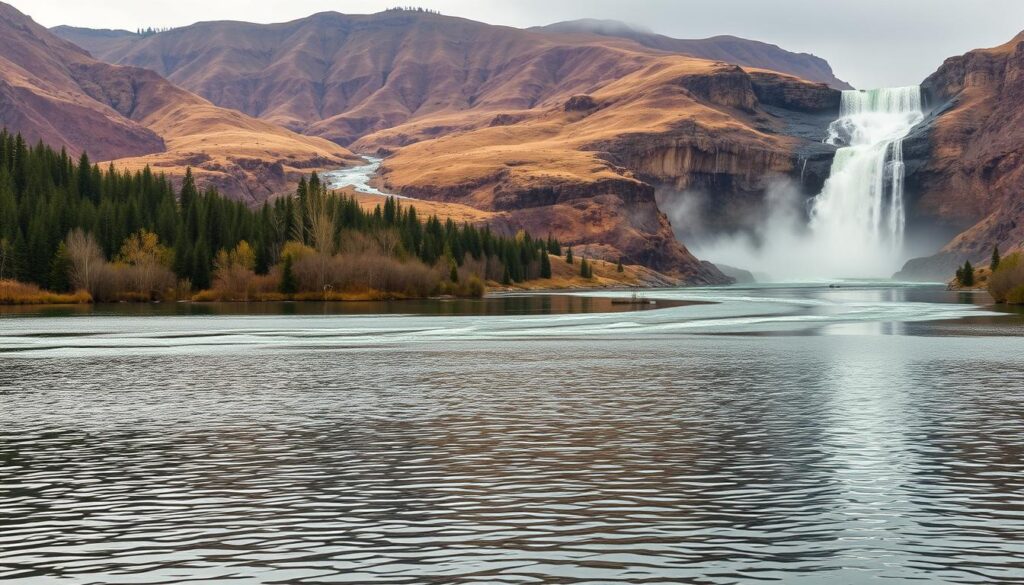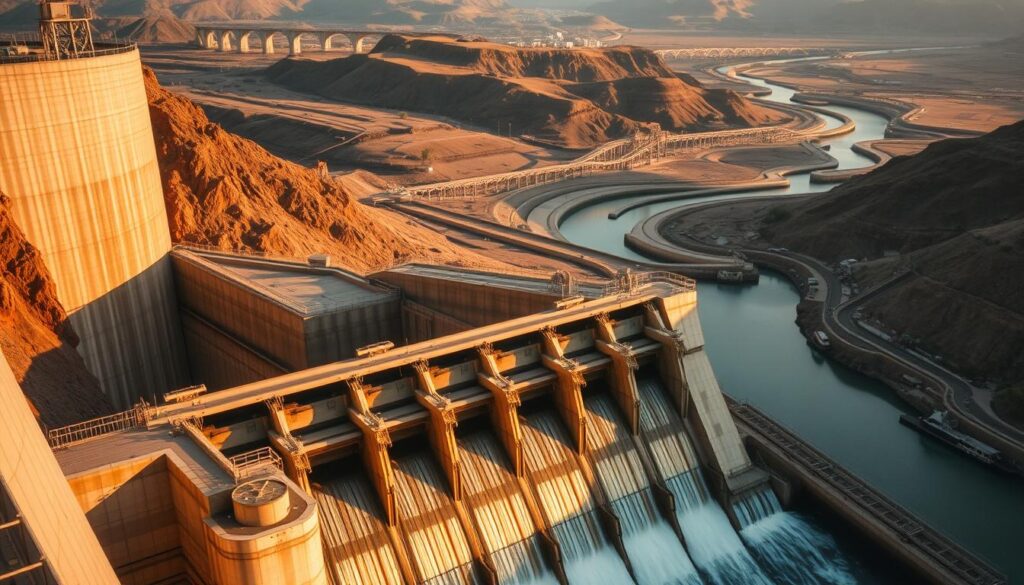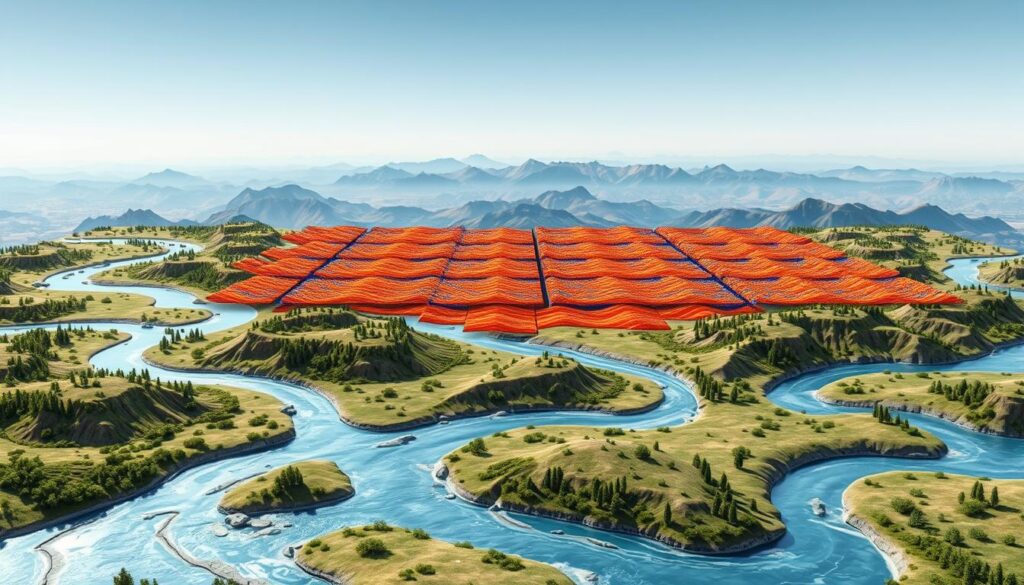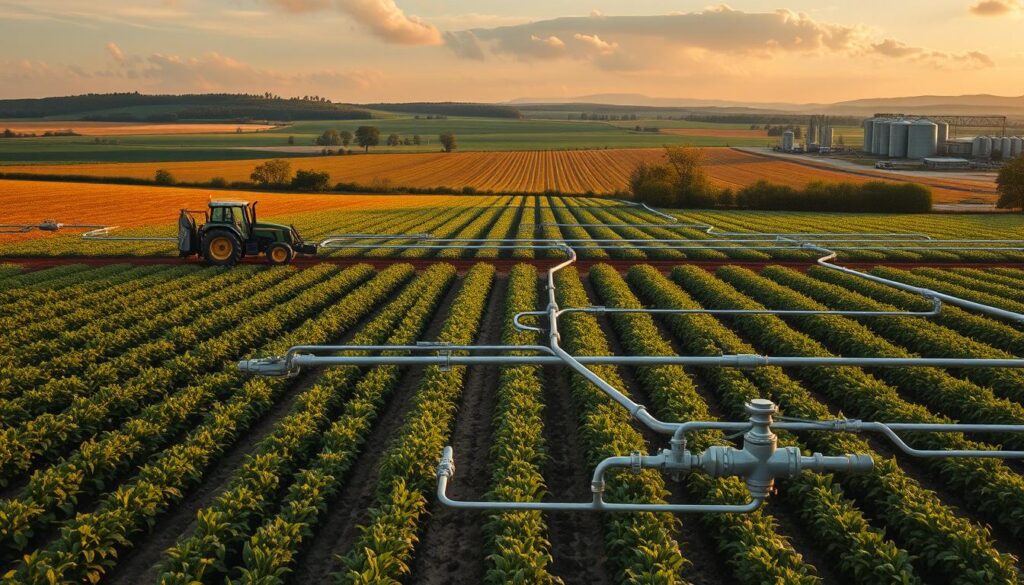Water is a vital component of our planet, with approximately 71% of the Earth’s surface covered by it. However, the distribution and movement of water are not uniform, making the study of hydrology and hydraulics crucial for managing water resources effectively.
Hydrology focuses on the occurrence, distribution, and movement of water, while hydraulics deals with the behavior of fluids in motion. Understanding these sciences is essential for various applications, including water resources engineering and environmental conservation. For instance, the principles of hydraulics are applied in designing hydraulic systems, such as those used in hydraulic lifts and construction equipment.
Key Takeaways
- Hydrology and hydraulics are crucial for understanding and managing water resources.
- These sciences have various applications in engineering and environmental conservation.
- Understanding the behavior of fluids in motion is key to designing efficient hydraulic systems.
- Water resources engineering is a vital field that relies on hydrology and hydraulics.
- Effective water management is essential for sustainable development.
Understanding Hydrology: The Study of Water
Understanding hydrology is essential for managing water resources effectively and mitigating the effects of floods and droughts. Hydrology encompasses the study of the water cycle, including precipitation, runoff, and infiltration, and is crucial for understanding the movement and distribution of water in various environments.
Definition and Importance of Hydrology
Hydrology is defined as the scientific study of the movement, distribution, and quality of water on Earth’s surface and in the atmosphere. Its importance lies in its ability to help manage water resources, predict and mitigate flood and drought impacts, and ensure sustainable water use.
The significance of hydrology can be seen in its applications, from watershed management to understanding surface water hydrology. Effective watershed management involves analyzing the hydrological characteristics of a watershed to predict its response to rainfall and other hydrological events.
The Water Cycle Explained
The water cycle, also known as the hydrological cycle, is the continuous process by which water is circulated between the Earth and the atmosphere. It involves several key processes: evaporation, condensation, precipitation, runoff, and infiltration.
| Process | Description |
|---|---|
| Evaporation | Water transforms from liquid to vapor. |
| Condensation | Water vapor cools and transforms back into liquid. |
| Precipitation | Water falls to the Earth’s surface as rain, snow, etc. |
| Runoff | Water flows over the land into streams, rivers, and lakes. |
| Infiltration | Water seeps into the soil, recharging groundwater. |
Key Concepts in Hydrology
Several key concepts are fundamental to understanding hydrology. These include the hydrological cycle, watershed dynamics, and groundwater flow. Understanding these concepts is crucial for managing water resources sustainably and predicting hydrological events.
By grasping these key concepts, hydrologists can better analyze and predict the behavior of water systems, ultimately contributing to more effective watershed management and water resource planning.
Fundamentals of Hydraulics: How Water Moves

The fundamentals of hydraulics reveal the intricacies of water movement and its significance. Hydraulics is the study of fluids in motion, involving the application of principles from fluid mechanics to understand the behavior of water in various environments, such as rivers and pipelines.
Definition and Importance of Hydraulics
Hydraulics is crucial for designing and managing systems that involve the flow of water. It encompasses the study of fluid dynamics, pressure, and flow rates, which are essential for understanding how water moves through different channels and structures.
For instance, in river morphology, hydraulics helps in understanding the sediment transport and erosion patterns, which are vital for maintaining healthy river ecosystems. The importance of hydraulics can be seen in its applications in various fields, including engineering, environmental science, and water resource management.
Key Applications of Hydraulics:
- Designing flood control systems
- Managing water supply networks
- Understanding river dynamics and morphology
Key Principles of Fluid Mechanics
Fluid mechanics is the backbone of hydraulics, providing the fundamental principles that govern the behavior of fluids. Key principles include the conservation of mass, momentum, and energy. These principles help in understanding how fluids flow, how pressure is distributed, and how energy is transferred within fluid systems.
“The study of fluid mechanics is essential for understanding the complex interactions between water and its environment, which is critical for managing water resources sustainably.” – Expert in Hydrology
To further illustrate the principles of fluid mechanics, consider the following table that outlines the basic equations used in hydraulics:
| Equation | Description | Application |
|---|---|---|
| Continuity Equation | Conservation of mass | Calculating flow rates |
| Bernoulli’s Equation | Conservation of energy | Understanding pressure and velocity relationships |
| Momentum Equation | Conservation of momentum | Analyzing forces on hydraulic structures |
For more information on hydraulics and its applications, you can visit the Hydrology and Hydraulics Training Series page, which provides comprehensive resources and training materials.
The Intersection of Hydrology and Hydraulics
The convergence of hydrology and hydraulics is pivotal in managing water resources effectively. These two sciences, while distinct, are interdependent in understanding and addressing various water-related challenges.
Real-world Applications
In real-world applications, the integration of hydrology and hydraulics is seen in the design and management of urban drainage systems. These systems are crucial in preventing urban flooding and ensuring that water is managed efficiently.
The application of hydrological principles helps in understanding rainfall patterns, runoff, and infiltration, which are critical in designing drainage systems. On the other hand, hydraulic principles guide the flow of water through these systems, ensuring that they are capable of handling the expected water volume.
How They Work Together in Engineering
In engineering projects, hydrology and hydraulics work together to create robust and sustainable water management solutions. For instance, in the design of flood control structures, hydrological data is used to predict flood events, while hydraulic analysis is used to determine the structural integrity and functionality of these structures.
The synergy between hydrology and hydraulics is also evident in the management of water resources, where understanding the hydrological cycle and hydraulic principles helps in optimizing water supply systems and ensuring water quality.
By combining these sciences, engineers can develop innovative solutions to complex water-related challenges, ultimately contributing to more sustainable and resilient water infrastructure.
Types of Water Bodies in Hydrology

Water bodies such as rivers, streams, lakes, reservoirs, and groundwater aquifers are fundamental components of hydrologic studies. Understanding the characteristics and behavior of these water bodies is crucial for managing water resources effectively.
Rivers and Streams
Rivers and streams are dynamic water bodies that play a significant role in shaping the landscape and supporting ecosystems. They are characterized by their flow rates, sediment transport, and water quality, which are influenced by factors such as rainfall, land use, and geology. Effective management of rivers and streams is essential for maintaining healthy watershed management practices.
For more information on the natural processes affecting groundwater, visit USGS Groundwater Information.
Lakes and Reservoirs
Lakes and reservoirs are important water bodies that store water for various uses, including drinking water supply, irrigation, and recreation. Their characteristics, such as water level, volume, and water quality, are influenced by factors like precipitation, evaporation, and human activities. Understanding these dynamics is vital for managing these water bodies sustainably.
Groundwater Aquifers
Groundwater aquifers are underground layers of permeable rock or soil that store significant amounts of water. These aquifers are recharged through infiltration of precipitation and surface water, and they supply water to wells and springs. Managing groundwater aquifers sustainably is critical for ensuring a reliable source of clean water for drinking, agriculture, and ecosystems.
In conclusion, understanding the different types of water bodies in hydrology is essential for effective water resources management. By studying rivers, streams, lakes, reservoirs, and groundwater aquifers, hydrologists can better manage these vital resources to support ecosystems and human activities.
Hydrologic Cycle: Detailed Breakdown
Understanding the hydrologic cycle is crucial for managing water resources effectively and mitigating the impacts of extreme weather events. The hydrologic cycle involves the continuous movement of water on, above, and below the surface of the Earth.
Processes Involved
The hydrologic cycle encompasses several key processes, including evaporation, condensation, precipitation, runoff, and infiltration. Evaporation occurs when the sun heats up water in rivers, lakes, and oceans, turning it into vapor. This water vapor rises into the atmosphere, where it cools down and undergoes condensation, forming clouds.
When these clouds become saturated with water, they release their water content back to the Earth as precipitation, which can be in the form of rain, snow, sleet, or hail. Once the precipitation reaches the ground, it can either flow over the surface as runoff or soak into the soil as infiltration.
Evaporation and Transpiration
Evaporation is a critical component of the hydrologic cycle, as it is the primary mechanism by which water is transferred from the Earth’s surface to the atmosphere. Transpiration, on the other hand, refers to the process by which plants release water vapor into the atmosphere through their leaves. Together, evaporation and transpiration contribute significantly to the water content in the atmosphere.
“The hydrologic cycle is a vital process that sustains life on Earth by continuously circulating water between the atmosphere, land, and oceans.”
Condensation and Precipitation
Condensation occurs when water vapor in the atmosphere cools down and changes back into liquid water, forming clouds, fog, or dew. Precipitation happens when these clouds become saturated and release their water content back to the Earth. Understanding these processes is essential for predicting weather patterns and managing water resources.
For more detailed information on the hydrologic cycle and its significance, visit this resource provided by Virginia Tech.
Runoff and Infiltration
Runoff occurs when precipitation flows over the land into streams, rivers, and lakes. This process can be influenced by factors such as land use, soil type, and topography. Infiltration, on the other hand, refers to the process by which precipitation seeps into the soil, recharging groundwater aquifers. Both runoff and infiltration play crucial roles in shaping our landscape and affecting water availability.
By understanding the various components of the hydrologic cycle, we can better manage water resources, mitigate the impacts of floods and droughts, and ensure a sustainable future for our planet.
Hydraulics in Urban Planning

Hydraulics is essential in urban planning for creating robust flood control measures and managing urban water systems. As cities grow and urbanize, the challenge of managing water resources becomes increasingly complex.
Effective urban planning requires a deep understanding of hydraulics to address urban drainage challenges. This involves designing systems that can handle heavy rainfall and prevent flooding, which is critical for protecting infrastructure and public safety.
Designing Flood Control Systems
Designing flood control systems is a critical aspect of urban hydraulics. These systems are designed to mitigate the impact of flooding by controlling the flow of water through urban areas.
- Levees and Floodwalls: Structures built to prevent overflow and protect urban areas from flooding.
- Stormwater Drainage Systems: Networks of drains and culverts that direct water away from urban centers.
- Pumping Stations: Facilities that pump water out of urban areas to prevent flooding.
Urban Hydrology Challenges
Urban areas face unique hydrological challenges, including increased runoff due to impervious surfaces like roads and buildings. This can lead to flash flooding and water quality issues.
To address these challenges, urban planners must employ advanced hydraulic modeling techniques and design innovative solutions that balance urban development with water management.
Some of the key challenges include:
- Managing increased runoff from urban surfaces.
- Ensuring the capacity of drainage systems to handle extreme weather events.
- Protecting water quality by reducing pollution from urban runoff.
By understanding and applying the principles of hydraulics, urban planners can create more resilient and sustainable cities.
Importance of Water Quality Monitoring
Effective water quality monitoring is crucial for maintaining the health of our water resources. It involves the systematic collection and analysis of water samples to determine their chemical, physical, and biological characteristics. This process helps in identifying potential sources of pollution and understanding their impact on hydrological systems.
Techniques for Assessing Water Quality
Various techniques are employed to assess water quality, including sampling and analysis. Sampling involves collecting water specimens from different sources, such as rivers, lakes, and groundwater aquifers. These samples are then analyzed in laboratories using various methods to determine their quality. Advanced technologies, such as remote sensing and real-time monitoring systems, are also being used to enhance the accuracy and efficiency of water quality assessment.
For more detailed information on water quality monitoring techniques, you can refer to studies published in reputable journals, such as the one available at Frontiers in Water.
Impact of Pollution on Hydrology and Hydraulics
Pollution has a significant impact on both hydrology and hydraulics. Contaminants in water bodies can alter their chemical composition, affecting the overall health of aquatic ecosystems. This, in turn, can influence hydraulic systems by changing water flow patterns and sediment transport. Understanding these impacts is crucial for developing effective strategies to mitigate pollution and protect our water resources.
The data collected from water quality monitoring is used to develop strategies for mitigating pollution. By understanding the sources and effects of pollutants, policymakers and environmental managers can implement measures to reduce pollution and protect water resources. This includes the development of regulations, conservation programs, and infrastructure improvements to ensure the long-term sustainability of our water supplies.
Hydraulic Structures: Definitions and Examples

Understanding hydraulic structures is key to managing water resources sustainably. Hydraulic structures are engineered to control, store, and convey water, playing a vital role in water management systems.
Dams and Weirs
Dams and weirs are types of hydraulic structures used to control water flow. Dams are barriers constructed across a river to impound water, while weirs are smaller barriers that allow water to flow over them. Both are crucial for water storage and flood control.
- Dams help in storing water for irrigation, drinking water, and hydroelectric power generation.
- Weirs are used to divert water into canals or to raise the water level for navigation.
For more information on how these structures are managed in project contexts, visit civil engineering in project management.
Spillways and Floodgates
Spillways and floodgates are critical components of hydraulic structures designed to manage excess water. Spillways are structures that allow water to flow over or around a dam, preventing it from overtopping. Floodgates are gates that can be opened or closed to control water flow, often used in flood control systems.
- Spillways help in safely releasing excess water from a dam.
- Floodgates are used to protect areas from flooding by controlling water flow.
Water Treatment Facilities
Water treatment facilities are essential hydraulic structures that ensure water is safe for consumption and other uses. These facilities treat water from various sources, removing contaminants and pollutants.
- Water treatment involves physical, chemical, and biological processes to remove impurities.
- Effective water treatment is crucial for public health and environmental protection.
In conclusion, hydraulic structures such as dams, weirs, spillways, floodgates, and water treatment facilities are vital for managing water resources and mitigating the impacts of flooding. Understanding their design and operation is essential for effective water management.
Software and Tools in Hydrology and Hydraulics
The study and management of water resources have been revolutionized by the use of specialized software and tools in hydrology and hydraulics. These technological advancements enable professionals to model, analyze, and predict water behavior with greater accuracy.
One of the critical areas where software plays a vital role is in modeling complex hydrological and hydraulic systems. Modeling software allows for the simulation of various scenarios, helping in the design and management of water infrastructure.
Modeling Software Overview
Several modeling software packages are widely used in the field. For instance, HEC-RAS is a popular choice for hydraulic modeling, allowing users to simulate water flow in rivers and streams. Other software, such as SWMM (Storm Water Management Model), is used for urban drainage analysis and flood modeling.
These tools provide valuable insights into water behavior under different conditions, aiding in the planning and management of water resources. They also help in assessing the impact of infrastructure projects on water flow and quality.
Data Collection Technologies
In addition to modeling software, data collection technologies play a crucial role in hydrology and hydraulics. Techniques such as remote sensing and GIS (Geographic Information System) are used to gather data on water bodies, land use, and other relevant factors.
Remote sensing technologies, including satellite imagery, help in monitoring water levels, quality, and other parameters over large areas. GIS, on the other hand, allows for the spatial analysis of hydrological data, facilitating better decision-making.
The integration of these technologies enhances our understanding of hydrological systems and improves the accuracy of hydraulic models. As a result, water resource management becomes more effective and sustainable.
Hydrological Modeling Techniques

Hydrological modeling techniques are crucial for understanding and managing water resources effectively. These techniques involve the use of mathematical models to simulate the behavior of water in various environments, helping predict and manage water flow.
As stated by the World Meteorological Organization, “Hydrological models are essential tools for water resource management, flood forecasting, and climate change impact assessment.” This emphasizes the importance of accurate modeling in real-world applications.
Rainfall-Runoff Models
Rainfall-runoff models are a critical component of hydrological modeling. They simulate the process by which rainfall becomes runoff, helping predict flood events and manage water resources. These models are vital for designing flood control systems and understanding the impact of land use changes on water flow.
The application of rainfall-runoff models involves complex algorithms that account for various factors, including soil moisture, vegetation cover, and topography. By analyzing these factors, hydrologists can better understand how different catchments respond to rainfall events.
Groundwater Flow Models
Groundwater flow models are another essential aspect of hydrological modeling. They help simulate the movement of water beneath the Earth’s surface, which is crucial for managing groundwater resources sustainably. These models can predict how groundwater levels will change over time, informing decisions on water supply and aquifer management.
Groundwater flow modeling involves understanding the hydraulic properties of aquifers, such as permeability and storage coefficients. By calibrating these models with field data, hydrologists can improve the accuracy of their predictions, supporting effective groundwater management strategies.
In conclusion, hydrological modeling techniques, including rainfall-runoff and groundwater flow models, are indispensable tools for water resource management. By applying these models, hydrologists and engineers can make informed decisions to mitigate flood risks, manage water supplies, and protect the environment.
The Role of Climate Change in Hydrology
Understanding the interplay between climate change and hydrology is crucial for managing water resources effectively. Climate change is altering precipitation patterns, melting glaciers, and affecting the distribution and movement of water around the world.
As the global climate continues to change, its impact on hydrological systems is becoming increasingly evident. Rising temperatures are altering evaporation rates, and changing precipitation patterns are affecting the frequency and severity of floods and droughts.
Impact on Water Resources
The impact of climate change on water resources is multifaceted. Changes in precipitation patterns and increased evaporation due to warmer temperatures are altering the availability of water. This can lead to more frequent and severe droughts in some regions and floods in others.
| Region | Projected Change in Precipitation | Potential Impact |
|---|---|---|
| Tropical regions | Increase | More frequent floods |
| Arid regions | Decrease | More severe droughts |
| Temperate regions | Variable | Increased variability in water supply |
For more information on how climate change affects hydrology, visit the University of California, Davis Water Management.
Adaptation Strategies
To mitigate the impacts of climate change on water resources, effective adaptation strategies are necessary. These can include improving water storage infrastructure, enhancing water efficiency, and implementing early warning systems for floods and droughts.
- Improving water management practices
- Enhancing watershed protection
- Developing climate-resilient water infrastructure
By adopting these strategies, communities can reduce their vulnerability to the impacts of climate change on water resources.
Hydraulics in Agriculture

Understanding hydraulics is crucial for optimizing irrigation efficiency and reducing water waste in agricultural practices. Hydraulics plays a significant role in designing and managing irrigation systems, which are vital for agricultural productivity.
The application of hydraulic principles in agriculture enables farmers to distribute water effectively across their fields. This not only improves crop yields but also helps in conserving water resources.
Irrigation Systems and Efficiency
Irrigation systems are a critical component of agricultural productivity. The efficiency of these systems depends on various hydraulic factors, including water pressure, flow rate, and pipe diameter.
Efficient irrigation systems can significantly reduce water waste and enhance crop yields. For instance, drip irrigation systems, which are designed based on hydraulic principles, deliver water directly to the roots of plants, minimizing evaporation and runoff.
| Irrigation System | Water Efficiency | Cost Effectiveness |
|---|---|---|
| Drip Irrigation | High | Moderate |
| Center Pivot Irrigation | Moderate | High |
| Surface Irrigation | Low | Low |
Water Management Practices
Effective water management is essential for sustainable agriculture. This involves adopting practices that optimize water use and reduce waste.
Precision agriculture techniques, which rely on hydraulic data, enable farmers to make informed decisions about irrigation. By analyzing soil moisture levels, weather forecasts, and crop water requirements, farmers can optimize their irrigation schedules.
Moreover, hydraulic modeling can help predict and manage water flow, reducing the risk of floods and droughts. This proactive approach to water management is crucial for ensuring the long-term sustainability of agricultural practices.
Case Studies in Hydrology and Hydraulics
Case studies in hydrology and hydraulics offer practical examples of how these sciences contribute to effective water management. By examining real-world applications, we can gain a deeper understanding of the challenges and solutions in managing water resources.
The integration of hydrology and hydraulics is crucial in designing and implementing successful water management projects. This section will highlight various case studies that demonstrate the application of these sciences in managing water resources.
Successful Projects in Flood Management
Flood management is a critical aspect of hydrology and hydraulics. Effective flood management strategies can mitigate the impact of floods on communities and infrastructure.
One notable example is the flood control measures implemented in the Netherlands. The Netherlands has a long history of managing floods, and its strategies have been studied and adopted worldwide.
- The use of advanced modeling software to predict flood patterns.
- Implementation of flood-resistant construction techniques.
- Creation of floodplain restoration projects to naturally mitigate flood impacts.
Innovative Solutions in Water Supply
Innovative solutions in water supply are essential for ensuring that communities have access to clean and reliable water. Hydrology and hydraulics play a key role in designing and managing water supply systems.
| Project | Location | Impact |
|---|---|---|
| Singapore’s NEWater | Singapore | Increased water supply through advanced water recycling technologies. |
| Desalination Plants | Various coastal regions | Provided alternative sources of freshwater, reducing reliance on traditional sources. |
| Rainwater Harvesting Systems | Australia, India | Reduced water consumption from municipal supplies, alleviating pressure on existing resources. |
These case studies demonstrate the importance of integrating hydrology and hydraulics in water management projects. By understanding and applying these sciences, we can develop more effective and sustainable solutions for managing water resources.
Educational Opportunities in Hydrology and Hydraulics

For individuals passionate about water and its role in our ecosystem, various educational pathways in hydrology and hydraulics are available. These fields offer a range of opportunities for those looking to make a difference in water management and conservation.
Academic Programs and Degrees
Several academic programs and degrees are available for those interested in pursuing a career in hydrology and hydraulics. These include:
- Bachelor’s and Master’s Degrees in Hydrology, Hydraulics, or related fields like Civil Engineering or Environmental Science.
- Ph.D. Programs for advanced research in hydrology and hydraulics, focusing on topics such as water resources management and flood risk assessment.
- Online Courses and certifications that offer flexible learning options for professionals looking to enhance their skills.
Certification and Workshops
In addition to academic programs, various certification programs and workshops are available to provide specialized training in hydrology and hydraulics. These include:
- Certified Hydrologist programs that recognize professionals with expertise in hydrologic analysis and water resources management.
- Workshops on topics such as hydraulic modeling, water quality assessment, and floodplain management.
- Professional Development opportunities that keep practitioners updated on the latest technologies and methodologies.
By exploring these educational opportunities, individuals can gain the knowledge and skills necessary to contribute to the fields of hydrology and hydraulics, ultimately helping to address the complex water challenges we face today.
Future Trends in Hydrological Research
Hydrological research is on the cusp of a revolution, driven by cutting-edge technology and a commitment to environmental sustainability. As the world grapples with the challenges of climate change, water scarcity, and environmental degradation, the need for innovative hydrological research has never been more pressing.
The integration of advanced technologies such as remote sensing, artificial intelligence (AI), and the Internet of Things (IoT) is transforming the field of hydrology. These technologies enable more accurate data collection, improved modeling, and enhanced prediction capabilities.
Advances in Technology
Technological advancements are playing a crucial role in shaping the future of hydrological research. Some of the key developments include:
- Remote Sensing: Allows for the collection of data over large areas, improving our understanding of hydrological processes.
- Artificial Intelligence (AI): Enhances data analysis and modeling, enabling more accurate predictions of hydrological events.
- Internet of Things (IoT): Facilitates real-time monitoring of water resources, improving management and decision-making.
As noted by a recent study, “The use of AI and machine learning in hydrology has the potential to revolutionize the field by providing more accurate and reliable predictions.”
“The integration of AI and IoT in hydrological research represents a significant step forward in our ability to manage water resources effectively.” – Dr. Jane Smith, Hydrologist
Sustainability and Eco-Friendly Practices
In addition to technological advancements, there is a growing emphasis on sustainability and eco-friendly practices in hydrological research. This includes:
| Practice | Description | Benefits |
|---|---|---|
| Sustainable Water Management | Implementing practices that ensure the long-term health of water resources. | Conserves water, reduces waste, and protects ecosystems. |
| Eco-Friendly Infrastructure | Designing infrastructure that minimizes environmental impact. | Reduces habitat destruction, preserves biodiversity. |
| Community Engagement | Involving local communities in water management decisions. | Enhances cooperation, improves outcomes. |
As hydrological research continues to evolve, it is clear that the future lies in the intersection of technology and sustainability. By embracing these trends, we can ensure a more water-secure future for generations to come.
Conclusion: The Impact of Hydrology and Hydraulics on Our Lives
Hydrology and hydraulics play a vital role in managing water resources, mitigating the impacts of floods and droughts, and promoting sustainability. Understanding the principles of these sciences is essential for developing effective strategies for water management.
Effective Water Management Strategies
Effective water management is crucial for ensuring the sustainability of our water resources. By applying the principles of hydrology and hydraulics, we can design and implement efficient systems for water supply, flood control, and irrigation.
Promoting Sustainability and Conservation
As we face the challenges of climate change and population growth, it is essential to promote sustainability and conservation in our water management practices. Continued research and innovation in hydrology and hydraulics will be critical in addressing these challenges and ensuring a sustainable future for our water resources.
